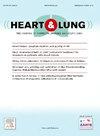The interplay between symptom deterioration of chronic obstructive pulmonary disease and chronic heart failure
IF 2.6
4区 医学
Q2 CARDIAC & CARDIOVASCULAR SYSTEMS
引用次数: 0
Abstract
Background
Chronic obstructive pulmonary disease (COPD) and chronic heart failure (CHF) commonly co-exist and share symptoms, which complicates disease management. It is unclear how COPD and CHF deterioration inter(re)act.
Objective
This study aimed to assess the interplay between COPD and CHF deterioration on group and individual level.
Methods
Total daily COPD- and CHF-symptom intensity scores (SIS) were calculated based on increased symptoms of COPD (dyspnea, sputum purulence and color, coughing, wheezing, fever) and CHF (sudden weight increase, swelling, nocturnal dyspnea), as reported by patients in one-year daily symptom diaries. The COPD-CHF interplay was assessed visually and statistically (on group and individual level) by mixed models.
Results
From a multicenter trial (N = 201), 33 patients with COPD and CHF (72.4 ± 7.8 years, 24 men (72.7 %)) were included. On group level, increased CHF-SIS positively predicted next day’s COPD-SIS (p = 0.02). However, on individual level, the direction and strength of the associations between CHF-SIS and subsequent COPD-SIS varied substantially. Vice versa, increased COPD-SIS also predicted next day’s CHF-SIS on group level (p < 0.001). On individual level, the direction of the associations varied less, although strength differed from negligible to strongly positive.
Conclusions
On group level, CHF deterioration predicts an increase in next day’s COPD symptom score, as well as vice versa. Individual-level associations reinforce the group-level results for COPD provoking CHF symptoms, but not for CHF provoking COPD symptoms. The COPD-CHF interplay should be monitored and, if present, acted upon to optimize patient disease management.
慢性阻塞性肺疾病症状恶化与慢性心力衰竭的相互作用
慢性阻塞性肺疾病(COPD)和慢性心力衰竭(CHF)通常共存并共享症状,这使疾病管理复杂化。目前尚不清楚COPD和CHF恶化是如何相互作用的。目的探讨慢性阻塞性肺病(COPD)与慢性心力衰竭(CHF)恶化在群体和个体水平上的相互作用。方法根据患者在1年每日症状日记中报告的COPD(呼吸困难、痰脓和颜色、咳嗽、喘息、发烧)和CHF(体重突然增加、肿胀、夜间呼吸困难)症状的增加,计算每日COPD和CHF症状强度评分(SIS)。采用混合模型对COPD-CHF相互作用进行视觉和统计评估(在组和个人水平上)。结果从一项多中心试验(N = 201)中纳入33例COPD和CHF患者(72.4±7.8岁,24例男性(72.7%))。在组水平上,CHF-SIS升高与次日COPD-SIS呈正相关(p = 0.02)。然而,在个体水平上,CHF-SIS与随后的COPD-SIS之间的关联方向和强度存在很大差异。反之亦然,COPD-SIS升高也可预测次日组水平的CHF-SIS (p <;0.001)。在个体水平上,关联的方向变化较小,尽管强度从可忽略到强正相关不等。结论在组水平上,CHF恶化预示次日COPD症状评分升高,反之亦然。个体水平的关联强化了COPD引发慢性心力衰竭症状的组水平结果,而非慢性心力衰竭引发COPD症状的组水平结果。应监测COPD-CHF的相互作用,如果存在,应采取行动以优化患者疾病管理。
本文章由计算机程序翻译,如有差异,请以英文原文为准。
求助全文
约1分钟内获得全文
求助全文
来源期刊

Heart & Lung
医学-呼吸系统
CiteScore
4.60
自引率
3.60%
发文量
184
审稿时长
35 days
期刊介绍:
Heart & Lung: The Journal of Cardiopulmonary and Acute Care, the official publication of The American Association of Heart Failure Nurses, presents original, peer-reviewed articles on techniques, advances, investigations, and observations related to the care of patients with acute and critical illness and patients with chronic cardiac or pulmonary disorders.
The Journal''s acute care articles focus on the care of hospitalized patients, including those in the critical and acute care settings. Because most patients who are hospitalized in acute and critical care settings have chronic conditions, we are also interested in the chronically critically ill, the care of patients with chronic cardiopulmonary disorders, their rehabilitation, and disease prevention. The Journal''s heart failure articles focus on all aspects of the care of patients with this condition. Manuscripts that are relevant to populations across the human lifespan are welcome.
 求助内容:
求助内容: 应助结果提醒方式:
应助结果提醒方式:


